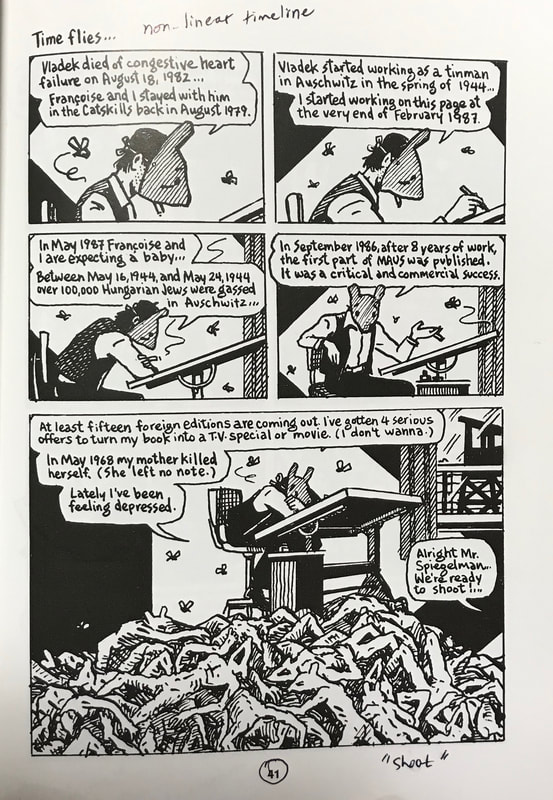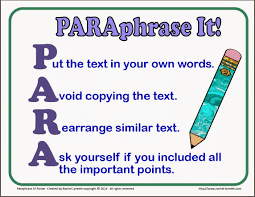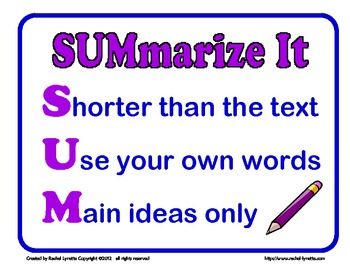|
Jane
2/26/2020 11:24:55
In conclusion, in this excerpt of the Maus, the author is trying to communicate with audience that if people are traumatized by something, it is hard for people to go back to normal life and even success can not bring happiness them. Therefore, he is criticizing the curelty of the Holocaust. To deliver his main argument successfully, he used stylistic devices such as diction like using word “shoot” ironically and symbolism like usage of mouse mask bodies of Jews.
Reply
Jane
2/26/2020 11:29:53
Using these stylistic devices, the author developed pathos by exposing his guilt of not experienced same difficulties like his parents did.
Reply
Joaquin villalon
2/26/2020 11:25:06
In conclusion, with with this article it showed figurative language of imagery, and images that show meaning. The flies represent death from a unknown source until the bottom panel is placed of dead bodies. Spegailman, is wearting a mask to shelter his same for the loss of Jews during ww2. This is why he wore the mask to hide his guilt of making maus book one and two. Later in the picture its shows in the dialogue of the for his fame in his book it has caught attention of producers or movie makers. As a result of this he covers himself to cry knowing that he got famous because of the millions a Jews that died in ww2.
Reply
Ruben
2/26/2020 11:25:17
The obvious conclusion to this page is that art is to distressed with all the publicity tha he has received leading to his representation in the story to fall apart at the seams. This also further establish the sort of lost perspective he has over the story due to him losing his loved one, and the many challenges he has on his personal life. You could also look at him continuing the story in the state he is in as a form of selfish depression due to him desperately trying to connect with his people, but can no longer handle the stress, because of the stories he was told by his father. Lastly the many bodies tat are on the floor could not only represent the lives lost in the war, but also all the personal demons he has faced at the time of publishing his novel.
Reply
Ralph Moran
2/26/2020 11:25:57
In short, Art suffers from the successfulness of his work as he wears a mask to hide his self image from the world. The files, dead mice, and the jumping around timeline sets a tone that only gets deeper and depressing by the second. As imagery plays a significant role towards all of the diction Art chooses to uses. Nonetheless, the tale of a son losing his mother is the most devastating one of all. Art position into fame and losing a loved one really puts a person at stake of potientially losing there own life and unfortunately Art’s heartless heart had stopped beating.
Reply
Maria
2/26/2020 11:28:38
In the book Maus, it demonstrated that the bags under his eyes, represent his stress from dealing with the trauma of his father’s death and his mother’s suicide. Also, that he found out that he is expecting a child with his wife. He is depressed, due to his survivor’s guilt and parent’s death. In the panel, it demonstrated a pile of death rats, to represent the bodies of all the Jews that were gassed in Auschwitz. The rats also represent his survivor’s guilt that he is going through as he is constantly haunted by the million of Jews who died.
Reply
Samantha Herrera
2/26/2020 11:33:02
The exercept of the graphic novel from Maus Book 2: Chapter 2 depicts the aftermath of Maus Book 1 and the effects that it had on the author. The purpose was to show that success does not ensure happiness through the author’s feelings of guilt and depression. In the given excerpt, the stylistic devices that were used were foreshadowing, imagery, and analogy through the graphic references and dialogue. The stylistic devices were successfully conveyed by the tone and mood of depression and gloom. Chapter 2 was able to convey the aftermath of Maus upon the author through its purpose, content, tone, mood, and stylistic devices with the use of the novel’s graphics.
Reply
Juan Lopez
2/26/2020 11:35:37
The conclusion for this excerpt is how depressed he is. He is sitting over a table wearing a mouse mask. He was suddenly under the spotlight, getting interviewed. As he is sitting atop he exposes the bodies who have suffered through the holocaust only for his own personal gain. Him wearing the mask makes him not feel entitled as a Jewish, but he cannot stop his famous book (project) so his fake identity has become a part of him.
Reply
Tania Reyes
2/26/2020 11:42:52
Throughout the chapter, Arthur Spiegelman expresses his emotions to the audience by using imagery and symbolism. He uses flies to portray death, a mask to hide his shame, pile of mice to show the many deaths of the holocaust. The purpose for why he wrote this book is to share his family’s story, to get people to see what they went through at the time. Although his book was a success, he’s still depressed and filled with survivor’s guilt. He got to share their story, but it’s still a constant reminder that these events happened and have a strong impact on him.
Reply
Jorge Cortez
2/26/2020 11:43:13
This page is for me very emotional. He talkes about his mother and father and how they are gone. He talks about very serios things. He makes himself Ku an try very t bond with the audience. Show that he is human as well. this was to shore a more emotion. he even has a mask on to show that’s he is hiding his depression. Been bough he has a child on the way he can’t shake the lives his parents lived and he has to come to terms with thqt even though he is only second generation Jew going through this
Reply
Elida
2/26/2020 11:45:03
To summarize Maus Book 2: Chapter 2, the author, Arthur Spiegelman is show that he is suffering from depression and survior’s guilt which he hides with a mask, this is caused from all the success that is brought on from Maus Book 1. The tone and mood helps us convey the idea of his unhappiness and shame. Chapter 2 was also able to convey of what happened to Arthur after Maus Book 1 from the use of stylistic devices, content and purpose.
Reply
itzmaray cerda
2/26/2020 11:45:41
In conclusion, the author Spiegelman suffers from depression after he published his book and wears a mask to hide his guilt of making those books. He uses literary devices such as imagery, symbolism, foreshadowing and diction
Reply
alisson
5/28/2024 09:53:27
this shows the importance of distinguishing between an author’s personal life and their creative work.
Reply
Sarahi
2/26/2020 11:46:05
Reply
Daniel
2/26/2020 11:49:32
The comic strip, “Time flies…,” shows us how Art Spiegelman feels about writing Maus through both direct statements and stylistic devices. It could be inferred that Spiegelman was both depressed and guilty. Spiegelman never got to see the holocaust, however, he was surrounded by those who were affected personally. As a result, he could tell this story about the holocaust was one born out of hardship and countless bodies. Absolutely riddled with the stench of death. Spiegelman must have felt guilty writing such a story, such a personal experience, for the wider masses, even if it wasn’t written for the money or notoriety. That’s why he didn’t want to commercialize it via TV shows or movies. However, the bodies and flies are a double entendre. As time flies by, quite literally in this case, Spiegelman has begun to visualize the holocaust more and more vividly, like he was there himself. This, coupled with the previous feelings of guilt, led to his depression.
Reply
zeendromix
5/28/2024 10:04:43
hi wsg man these comments they are fun to read
Reply
kendrick
5/28/2024 10:11:39
Psst, I see dead people
Reply
5/29/2024 08:20:13
Money is the anthem of success
Reply
Leave a Reply. |
What Grade is My Writing?
|
||||||
| two-step_mla_documentation.pdf | |
| File Size: | 1967 kb |
| File Type: | |


